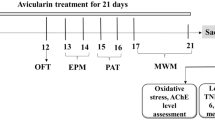Deposition of beta-amyloid peptide in the brain observed in Alzheimer’s disease contributes to the development of cognitive deficits. We studied the abilities of different neuroprotectors to prevent or reduce degeneration of hippocampal neurons in rat brain 14 and 45 days after single intrahippocampal injection of beta-amyloid peptide 25-35 (Aβ25-35). Cytological analysis of the neurons of the hippocampal CA1 and CA3 fields showed predominant damage to CA1 neurons in 14 days and CA3 neurons in 45 days after Aβ25-35 administration. Single preliminary administrations of neuroprotectors fullerene C60FWS (antioxidant), neuromedin (nonselective inhibitor of acetylcholinesterase), and AM404 (activator of the endocannabinoid system) largely prevented neurodegeneration of neurons. Fullerene produced the most pronounced protective effect, which can be explained by its ability to prevent aggregation of proteins and destroy Aβ25-35 fibrils. The combined use of these neuroprotectors can provide the basis for the development of new approaches to prevention and treatment of Alzheimer’s disease.
Similar content being viewed by others
References
Damulin IV, Zhivolupov SA, Zaitsev OS, Maksimova MYu, Markin SP, Samartsev IN, Sanadze AG, Strokov IA. Neuromedin in Clinical Practice. Moscow, 2016. Russian.
Fernández-Cabello S, Kronbichler M, Van Dijk KRA, Goodman JA, Spreng RN, Schmitz TW; Alzheimer’s Disease Neuroimaging Initiative. Basal forebrain volume reliably predicts the cortical spread of Alzheimer’s degeneration. Brain. 2020;143(3):993-1009. doi: https://doi.org/10.1093/brain/awaa012
Gordon R, Podolski I, Makarova E, Deev A, Mugantseva E, Khutsyan S, Sengpiel F, Murashev A, Vorobyov V. Intrahippocampal pathways involved in learning/memory mechanisms are affected by intracerebral infusions of amyloid-β25-35 peptide and hydrated fullerene C60 in rats. J. Alzheimers Dis. 2017;58(3):711-724. doi: https://doi.org/10.3233/JAD-161182
Grothe M, Heinsen H, Teipel SJ. Atrophy of the cholinergic Basal forebrain over the adult age range and in early stages of Alzheimer’s disease. Biol. Psychiatry. 2012;71(9):805-813. doi: https://doi.org/10.1016/j.biopsych.2011.06.019
**no S. Topographic differences in adult neurogenesis in the mouse hippocampus: a stereology-based study using endogenous markers. Hippocampus. 2011;21(5):467-480. doi: https://doi.org/10.1002/hipo.20762
Llorens-Martín M, Blazquez-Llorca L, Benavides-Piccione R, Rabano A, Hernandez F, Avila J, DeFelipe J. Selective alterations of neurons and circuits related to early memory loss in Alzheimer’s disease. Front. Neuroanat. 2014;8:38. doi: https://doi.org/10.3389/fnana.2014.00038
Lothmann K, Deitersen J, Zilles K, Amunts K, Herold C. New boundaries and dissociation of the mouse hippocampus along the dorsal-ventral axis based on glutamatergic, GABAergic and catecholaminergic receptor densities. Hippocampus. 2021;31(1):56-78. doi: https://doi.org/10.1002/hipo.23262
Makarova EG, Gordon RY, Podolski IY. Fullerene C60 prevents neurotoxicity induced by intrahippocampal microinjection of amyloid-beta peptide. J. Nanosci. Nanotechnol. 2012;12(1):119-126. doi: https://doi.org/10.1166/jnn.2012.5709
Nelson AR, Kolasa K, McMahon LL. Noradrenergic sympathetic sprouting and cholinergic reinnervation maintains non-amyloidogenic processing of AβPP. J. Alzheimers Dis. 2014;38(4):867-879. doi: https://doi.org/10.3233/JAD-130608
Páez JA, Campillo NE. Innovative therapeutic potential of cannabinoid receptors as targets in Alzheimer’s disease and less well-known diseases. Curr. Med. Chem. 2019;26(18):3300-3340. doi: https://doi.org/10.2174/0929867325666180226095132
Podolski IY, Podlubnaya ZA, Kosenko EA, Mugantseva EA, Makarova EG, Marsagishvili LG, Shpagina MD, Kaminsky YG, Andrievsky GV, Klochkov VK. Effects of hydrated forms of C60 fullerene on amyloid 1-peptide fibrillization in vitro and performance of the cognitive task. J. Nanosci. Nanotechnol. 2007;7(4-5):1479-1485. doi: https://doi.org/10.1166/jnn.2007.330
Scheiderer CL, McCutchen E, Thacker EE, Kolasa K, Ward MK, Parsons D, Harrell LE, Dobrunz LE, McMahon LL. Sympathetic sprouting drives hippocampal cholinergic reinnervation that prevents loss of a muscarinic receptor-dependent long-term depression at CA3-CA1 synapses. J. Neurosci. 2006;26(14):3745-3756. doi: https://doi.org/10.1523/JNEUROSCI.5507-05.2006
Shankar GM, Walsh DM. Alzheimer’s disease: synaptic dysfunction and Aβ. Mol. Neurodegeneration. 2009;4:48. doi: https://doi.org/10.1186/1750-1326-4-48.
Talarico G, Trebbastoni A, Bruno G, de Lena C. Modulation of the cannabinoid system: a new perspective for the treatment of the Alzheimer’s disease. Curr. Neuropharmacol. 2019;17(2):176-183. doi: https://doi.org/10.2174/1570159X16666180702144644
Yeung JHY, Palpagama TH, Tate WP, Peppercorn K, Waldvogel HJ, Faull RLM, Kwakowsky A. The acute effects of amyloid-beta 1-42 on glutamatergic receptor and transporter expression in the mouse hippocampus. Front. Neurosci. 2020;13:1427. doi: https://doi.org/10.3389/fnins.2019.01427
Author information
Authors and Affiliations
Corresponding author
Additional information
Translated from Byulleten’ Eksperimental’noi Biologii i Meditsiny, Vol. 172, No. 10, pp. 452-458, October, 2021
Rights and permissions
About this article
Cite this article
Gordon, R.Y., Makarova, E.G., Mugantseva, E.A. et al. Analysis of the Effect of Neuroprotectors That Reduce the Level of Degeneration of Neurons in the Rat Hippocampus Caused by Administration of Beta-Amyloid Peptide Aβ25-35. Bull Exp Biol Med 172, 441–446 (2022). https://doi.org/10.1007/s10517-022-05410-9
Received:
Published:
Issue Date:
DOI: https://doi.org/10.1007/s10517-022-05410-9




